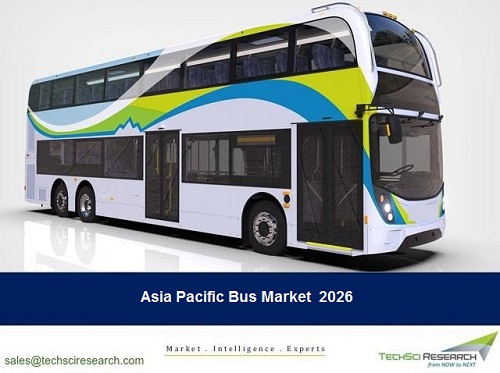
Growing environmental concerns because of diesel buses and increasing government initiatives for adoption of electric buses to drive the Asia Pacific Bus market through 2026.
According to TechSci Research report, “Asia Pacific Bus Market By Length Type (Less than 8m, Between 8m-10m, Between 10m-12m, Greater than 12m), By Fuel Type (Diesel, Petrol/Gasoline, Gas, Electric, Hybrid), By Seating Capacity (Less than 30, Between 30-40, Greater than 40), By Body Type (Fully Built, Customizable), By Application (Transit Bus, School Bus/Others, Motorcoaches), By Country, Competition, Forecast & Opportunities, 2026”, Asia Pacific Bus market is anticipated to reach 42.57 thousand units by 2026 because of growing environmental concerns about diesel buses, which emit a lot of pollution that is harmful to people’s health and the environment, as well as increasing government measures to encourage the use of electric buses. Due to increasing fleet of personal two-wheelers and four-wheeler vehicles on roads, the level of pollution is increasing day by day which is a huge concern. Not only this, increasing fleet of personal vehicles is affecting the environment and also leading to traffic congestion which is creating lots of issues for the daily travellers on the roads. To overcome the issue of environmental pollution and traffic congestion governments are taking necessary steps like promoting buses for daily travelling by decreasing subsidies on buses and benefits for increasing the adoption rate of electric vehicles and replacing heavy-duty diesel and gasoline-run buses with zero-emission electric buses. Electric buses have the potential to significantly reduce pollution levels because no gases will escape from the vehicle and produce pollution. However, because more people will opt to commute by bus as a result of increased bus services, these buses will also help to reduce traffic congestion. However, the deployment of electric buses will depend upon country wise policy and also the number of charging stations in respective countries. To run the electric buses on roads, countries should have a strong charging infrastructure to avoid problems.
Browse more than 55 market data Figures spread through 80 Pages and an in-depth TOC on “Asia Pacific Bus Market”
https://www.techsciresearch.com/report/asia-pacific-bus-market/3411.html
Asia Pacific Bus market can be segmented on the basis of length, by fuel type, by seating capacity, by body type and by application. Based on length type, less than 8m buses is leading the market. But in 2020, the sales of buses with length 10m-12m increased because of their for intracity and intercity application. In by fuel type, diesel buses are dominating the market with over 90% market share in 2020. In the forecast period also, it is expected that diesel buses will dominate the bus market, but electric buses segment is expected to grow at a CAGR of 24.18% in comparison to diesel buses. In by seating capacity segment, the buses with below 30 seats are leading the market because of their high demand for intracity purposes. In by body type segment, the fully built buses are dominating the Asia pacific bus market and in forecast period also they are expected to dominate the market. In by application type bus segment, transit buses are leading the market because of their high demand as intracity buses and followed by motorcoaches. The demand for motorcoaches buses is also more because such buses are used mainly as intercity buses and also for the sightseeing purpose.
Major players operating in Asia Pacific Bus market are Toyota Motor Corporation, SML Isuzu Ltd., Hino Motors, Ltd. etc., are among some of the leading players operating in Asia Pacific Bus market. Apart from these companies, AB Volvo, MAN, Daimler AG, Nissan and Mitsubishi Fuso Truck and Bus Corporation are key players, who are developing advanced technologies and launching new products to stay competitive in the market. Other competitive strategies adopted by market players include mergers and acquisition, new product developments and increasing their marketing activities and enriching product portfolio globally to increase their customer outreach.
Download Sample Report @ https://www.techsciresearch.com/sample-report.aspx?cid=3411
Customers can also request for 10% free customization on this report.
“In 2020, Japan accounted for the largest share i.e., 40.63% in Asia Pacific Bus market and it is expected to dominate in the forecast period also. Japan is leading the Asia Pacific Bus market because of increasing tourism and awareness among people regarding using buses”, said Mr. Karan Chechi, Research Director with TechSci Research, a research based global management consulting firm.
“Asia Pacific Bus Market By Length Type (Less than 8m, Between 8m-10m, Between 10m-12m, Greater than 12m), By Fuel Type (Diesel, Petrol/Gasoline, Gas, Electric, Hybrid), By Seating Capacity (Less than 30, Between 30-40, Greater than 40), By Body Type (Fully Built, Customizable), By Application (Transit Bus, School Bus/Others, Motorcoaches), By Country (Australia, Singapore, Thailand, Taiwan, Malaysia, Japan, New Zealand, Indonesia), Competition, Forecast & Opportunities, 2026” has evaluated the future growth potential of Asia Pacific Bus market and provides statistics & information on market size, structure and future market growth. The report intends to provide cutting-edge market intelligence and help decision makers take sound investment decisions. Besides, the report also identifies and analyzes the emerging trends along with essential drivers, challenges, and opportunities in Asia Pacific Bus Market.
Contact
Mr. Ken Mathews
708 Third Avenue,
Manhattan, NY,
New York – 10017
Tel: +1-646-360-1656
Email: [email protected]
